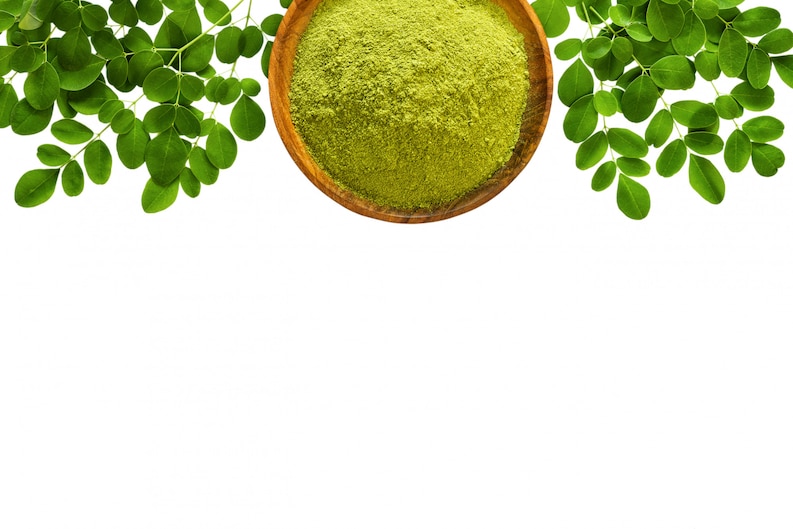Moringa plant, revered as the “Miracle Tree,” has gained significant attention for its exceptional health benefits and culinary versatility. In Indian cuisine, every part of the Moringa plant, including leaves, pods, flowers, seeds, and roots, is utilized for its unique nutritional properties and culinary applications.
Moringa Leaves:
Moringa leaves are a nutritional powerhouse, offering a wide range of health benefits. They are an excellent source of vitamins A, C, and E, as well as minerals like calcium, iron, and potassium. The leaves are known for their potent antioxidant and anti-inflammatory properties, which can support immune function, reduce inflammation, and promote overall well-being. In Indian cuisine, Moringa leaves are used in various dishes, such as:
Moringa Leaf Curry (Moringa Sambar): In this popular South Indian dish, Moringa leaves are cooked with lentils, tamarind, and a flavourful blend of spices. The result is a tangy and nutritious curry that is typically served with steamed rice or dosa.
- Moringa Leaf Stir-Fry (Moringa Thoran): This traditional Kerala dish involves stir-frying Moringa leaves with coconut, shallots, mustard seeds, and spices. The dish is known for its vibrant colors and aromatic flavors, often served as a side dish with rice and other curries.
- Moringa Leaf Chutney: Moringa leaves can also be used to prepare a flavourful chutney. The leaves are blended with coconut, roasted lentils, green chilies, and tamarind to create a tangy and spicy condiment that complements dosa, idli, or rice.
Moringa pods, commonly known as drumsticks, are another valuable component of the plant. They are a rich source of vitamin C, calcium, and iron. Drumsticks offer numerous health benefits, including improved bone health, enhanced immune function, and better digestion. In Indian cuisine, drumsticks are used in various dishes, such as:
- Drumstick Sambar: Sambar is a flavourful lentil-based curry, and the addition of drumsticks adds a unique taste and texture to the dish. The combination of lentils, vegetables, tamarind, and aromatic spices creates a delightful and nutritious curry often served with rice or idli.
- Drumstick Curry (Murungakkai Kuzhambu): This tangy and spicy curry is a popular South Indian dish. Drumsticks are cooked in a rich gravy made from coconut, onions, tomatoes, and a blend of spices. The result is a delectable curry that pairs well with rice or roti.
Moringa Flowers:
Moringa flowers not only add visual appeal to dishes but also offer health benefits. They are rich in antioxidants and possess anti-inflammatory properties. In Indian cuisine, Moringa flowers are used in various ways, including:
- Moringa Flower Stir-Fry: The flowers are stir-fried with onions, green chilies, and a combination of spices to create a vibrant and aromatic dish. This simple yet flavorful stir-fry is often served as a side dish with rice and dal.
- Moringa Flower Soup: Moringa flowers can be added to soups, enhancing their nutritional profile and adding a delicate flavor. The flowers are cooked with vegetables, lentils, and spices to create a comforting and nutritious soup.
Moringa Seeds:
Moringa seeds are small but mighty and packed with essential nutrients. They are a rich source of protein, healthy fats, and fiber. Moringa seeds are known for their antioxidant and anti-inflammatory properties, contributing to overall health. In Indian cuisine, moringa seeds are used in various dishes, such as:
- Moringa Seed Chutney: The seeds are roasted and ground to make a flavorful chutney. They are combined with coconut, spices, and tamarind to create a tangy and aromatic condiment that complements dosa, idli, or rice.
- Moringa Seed Curry: Moringa seeds can also be used to prepare a delicious curry. The seeds are cooked in a spiced gravy made from coconut, onions, tomatoes, and aromatic spices. This hearty curry can be enjoyed with rice or roti.
Moringa Plants:
- Although less commonly used in Indian cuisine, Moringa roots have their place in traditional medicine. The roots are believed to possess antimicrobial and anti-inflammatory properties. It’s important to note that the roots of the Moringa plant should be used with caution, as they may have potential toxic effects if consumed in large quantities.
Conclusion:
- With its remarkable health benefits and versatile uses in Indian cuisine, it exemplifies the synergy between food and wellness. From the nutrient-dense leaves and flavorful pods to the vibrant flowers and nutrient-rich seeds, every part of the Moringa plant offers unique attributes that contribute to overall health and well-being.
- By incorporating this into our culinary practices, we not only elevate the nutritional value and flavors of our meals but also embrace the rich heritage of Indian cuisine and the holistic benefits it provides.





